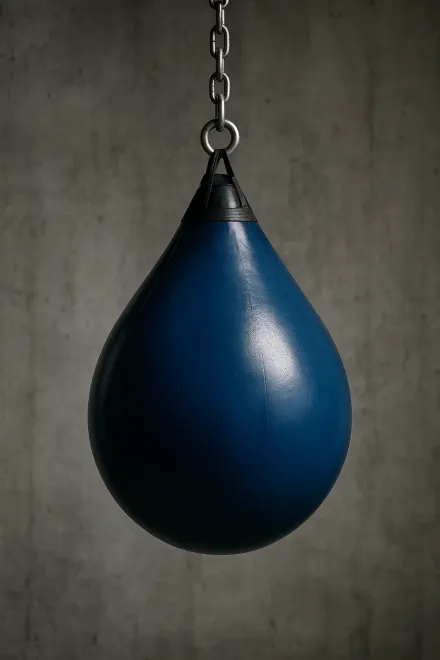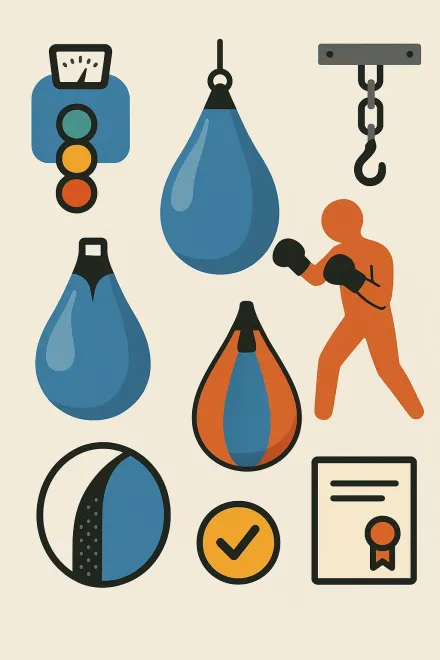Water-filled boxing bags
Water-filled boxing bags have become an innovative alternative to traditional sand or textile-filled bags. Thanks to their composition, they offer a far more realistic striking experience, better absorbing impact and reducing the risk of injury. This type of bag is specially designed to simulate the feeling of hitting a real opponent, which makes it a highly valued training tool for boxers, martial artists and fitness enthusiasts. In this complete guide you will discover how they work, what advantages they offer and what to consider before choosing the ideal model for your training.
See water-filled boxing bags on Amazon
What is a water-filled boxing bag?
A water-filled boxing bag is a training bag filled primarily with water instead of sand or fiber. This feature provides a more flexible surface that adapts to the strike and dissipates impact force. Unlike traditional bags, the water version generates a much more natural feel, similar to hitting the human body.
This type of bag is made from highly resistant materials, generally high-density PVC, ensuring durability even during intensive training. It hangs from the ceiling or a frame using chains or special mounts, and you can adjust hardness by changing the amount of water.
Today, water-filled boxing bags are used both in professional gyms and at home, as they offer versatile, safe training for all ages.
Advantages of training with a water-filled boxing bag
Choosing a water-filled boxing bag brings multiple benefits that set it apart from traditional models. Here are some key advantages:
- Impact absorption: water lowers pressure on joints and knuckles, helping prevent injuries.
- Realistic feel: striking closely resembles contact with the human body.
- Durability: built with high-resistance materials to withstand intensive training.
- Adjustable firmness: vary the water level to modify the bag's hardness.
- Less noise: without solid fill, they produce a softer sound on impact.
In short, water bags not only improve technique and training experience, they also help prevent common issues such as wrist sprains or elbow inflammation.


How to choose the right water-filled boxing bag
When buying a water-filled boxing bag, it is important to consider several aspects to ensure it suits your needs:
- Size and weight: models range from 15 to over 50 kilos when filled. Pick one that matches your level and training style.
- Shape: some are round, others teardrop-shaped. Choose based on whether you focus on straight punches or more technical combos.
- Installation: check that the bag includes a chain, hook or mounting system. Also consider the strength of the ceiling or frame you will use.
- Material: look for high-density PVC or reinforced coatings that guarantee durability.
- Brand and warranty: choosing recognized manufacturers ensures better after-sales support and buying confidence.
If you are a beginner, a medium-sized bag may be enough. For advanced boxers or martial artists, larger, heavier models offer a more demanding experience.
Training tips for water bags
Training with a water-filled boxing bag requires technique and consistency to maximize its benefits. Here are some practical tips:
- Always warm up first: spend at least 10 minutes on mobility, jumping and shadowboxing.
- Vary your strikes: mix straights, hooks and uppercuts to work different angles and improve coordination.
- Work in rounds: simulate real bout dynamics with sets of 3 minutes on and 1 minute off.
- Do not neglect defense: practice footwork, blocks and slips between combinations.
- Use proper gloves: even though the bag absorbs impact well, always wear boxing gloves to protect wrists and knuckles.
- Regulate intensity: alternate power sessions with technical work to avoid overuse.
A common mistake is hitting only at maximum power. Remember the goal with a water bag is not just to improve punching, but also to refine technique, boost cardiovascular endurance and simulate real fight situations.
Maintenance and care for a water-filled boxing bag
To extend your water-filled boxing bag's lifespan, basic, consistent maintenance is essential. Here are some recommendations:
- Check pressure: periodically ensure the water level is right. If the bag feels too soft or too hard, adjust the fill.
- Inspect materials: examine PVC and seams for wear or cracks that could cause leaks.
- Use strong mounts: make sure chains, hooks and the ceiling can handle the bag's full weight.
- Regular cleaning: wipe with a damp cloth after each session to prevent sweat or dust buildup.
- Proper location: avoid direct sun or extreme temperatures, which can damage materials.
- Drain when unused: if you will not train for a long time or need to transport it, empty the bag to reduce weight and make moving easier.
With these steps, your water bag can last many years without losing its impact-absorption qualities. Investing in good maintenance is key to getting the most from this training equipment.
Frequently asked questions about water-filled boxing bags
What is the difference between a water bag and a traditional one?
The main difference is the filling. While traditional bags are usually filled with sand, fibers or compressed textile, water bags use liquid as a shock absorber. This delivers a more realistic striking feel and reduces pressure on joints and knuckles. They are also quieter and versatile, though they require a robust installation to bear the weight.
Are water bags recommended for beginners?
Yes, they are an excellent choice for beginners because they absorb impact better and lower injury risk. By more faithfully simulating contact with an opponent, they help develop realistic technique from the start. Do begin with a medium-sized model and always use proper gloves to protect your hands.
Can they be used without gloves?
It is not advisable to train on water bags without gloves. Although water absorbs impact better than sand, knuckles and wrists are still exposed to micro-injuries with repeated strikes. Using boxing gloves or protective wraps helps prevent sprains, inflammation or small fractures.
What weight water bag should I choose?
The ideal weight depends on your level and goals. Lighter models (15–25 kg) suit beginners or speed work. Mid-range (30–40 kg) bags are the most versatile for most users. Heavier options (50 kg or more) are intended for advanced boxers and power training.
How is a water-filled boxing bag installed?
Installation must be on a strong ceiling or frame, since a filled water bag can easily exceed 40 or 50 kilos. They typically include chains and a hook that attach to a metal mount. It is important to ensure the surface supports the weight to avoid accidents.
Do they require much maintenance?
Not much, but they do need periodic checks. Monitor the water level, inspect seams and clean the surface after workouts. If the bag will be unused for a long time, it is best to drain it to prolong durability. With basic care, a water bag can last many years in top condition.
Can I use a water bag for sports other than boxing?
Yes, water bags are useful for multiple contact disciplines such as kickboxing, Muay Thai or mixed martial arts. Because they absorb kicks and punches well, they offer very versatile training. They can even be used in high-intensity fitness routines to improve endurance and strength.
